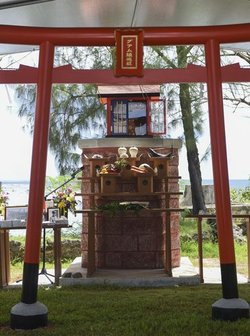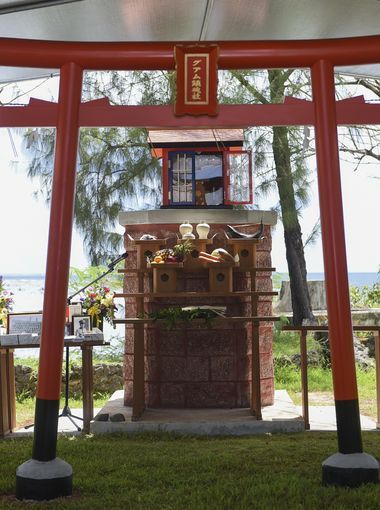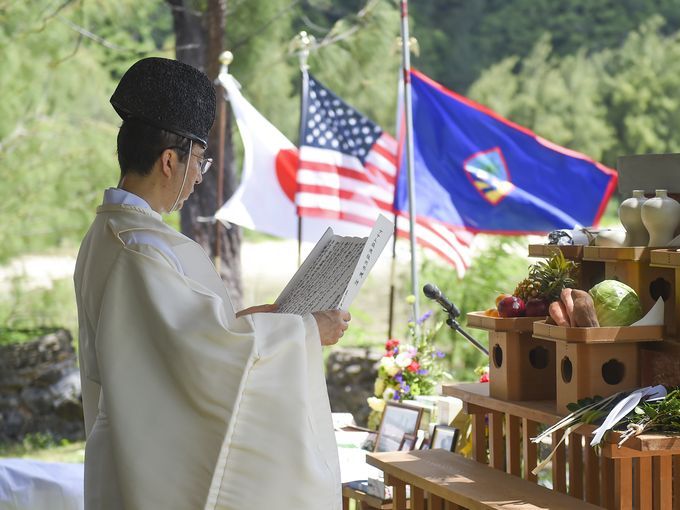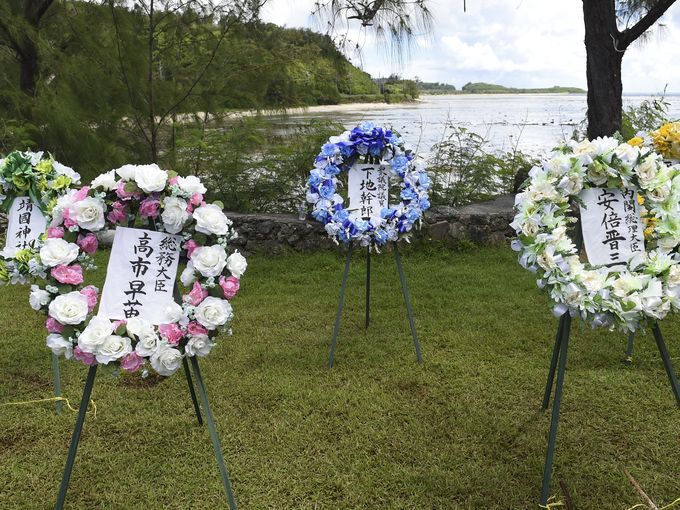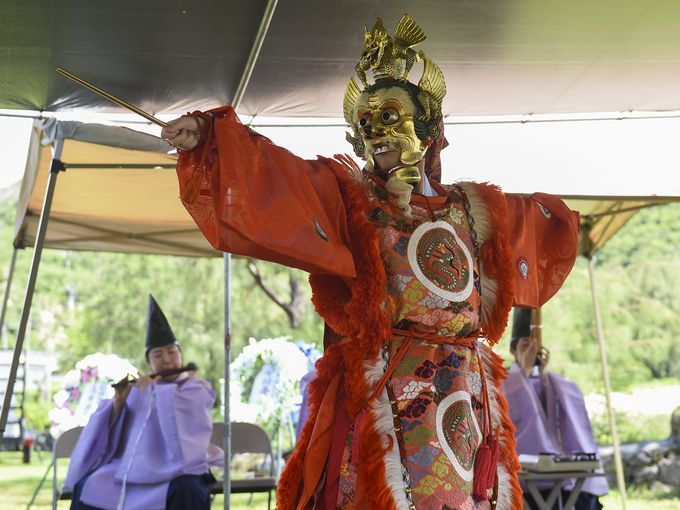By Andrew Roberto
“I have a dream that somehow those spirits (from WWII) need to settle. They need to cease. They need somewhere to be."
– U.S. Explore and Study President Ken Haga
Local leaders and Japanese delegates gathered in Adelup to promote peace and honor those who died during World War II during a small ceremony to erect a Japanese shrine overlooking Asan Bay.
The Guam Chinkon Shrine now stands adjacent to the WWII-era artillery gun only a few yards south of the Latte of Freedom.
In unveiling the new shrine, Guam Lt. Gov. Ray Tenorio underscored the importance of its specific position at the Governor’s Complex.
“I think contrast is one of the most important conversations we can have — yin and yang, black and white, war and peace,” began Lt. Gov. Tenorio. “You have the weapon of war on the same footprint as we have a peace memorial. This piece of war is rusting away, and this peace memorial is new and pristine. That’s the way we want war and conflict to be, and that’s the way we want peace and harmony to be.”
U.S. Explore and Study President Ken Haga was instrumental in creating the shrine and along with The Unforgotten Sacrifices of War organization, brought in Shinto priests and musicians for the ceremony.
“I have a dream that somehow those spirits (from WWII) need to settle. They need to cease. They need somewhere to be,” Haga said in remarks to the crowd gathered in Adelup for the ceremony.
According to a press release from U.S. Explore and Study, "Chinkon" means sea of souls.
During the blessing of the shrine, Yasukuni high priests lead those gathered in a small Shinto prayer service. Afterwards, a traditional Bagaku dancer performed in full traditional attire to the accompaniment of instruments native to Japan. In closing the ceremony, the gathered crowd was allowed to lay flowers at the Guam Chinkon Shrine altar.
Haga and and his associates have coordinated different peace ceremonies on Guam during the past five years, all of which were dedicated to CHamorus, Americans and Japanese who suffered during WWII. The dedication ceremony for the Guam Chinkon Shrine is special in that it has a connection to and authorization from the Yasukuni Jinjya, a national shrine of great importance to the imperial family of Japan. According to the Japanese shrine’s official website, Yasukuni Jinjya enshrines more than two million Japanese soldiers who died for their country since 1869.
Guam’s Chinkon Shrine will honor all people who died for their country, regardless of nationality, according to Haga. He said he hopes the ceremony will leave a legacy of peace on the island.
“Look at this cannon, it’s already 73 years there. (Guam Chinkon Shrine) is stone, more than a hundred century, it will lie,” Haga said. “After we pass away, still the monument will be here. We are eye witnesses to history. And this is magic, it’s a miracle.”
Rewritten from information published in the Guam Daily Post (Tamuning, Guam) on July 10, 2017.
By Andrew Roberto
“I have a dream that somehow those spirits (from WWII) need to settle. They need to cease. They need somewhere to be."
– U.S. Explore and Study President Ken Haga
Local leaders and Japanese delegates gathered in Adelup to promote peace and honor those who died during World War II during a small ceremony to erect a Japanese shrine overlooking Asan Bay.
The Guam Chinkon Shrine now stands adjacent to the WWII-era artillery gun only a few yards south of the Latte of Freedom.
In unveiling the new shrine, Guam Lt. Gov. Ray Tenorio underscored the importance of its specific position at the Governor’s Complex.
“I think contrast is one of the most important conversations we can have — yin and yang, black and white, war and peace,” began Lt. Gov. Tenorio. “You have the weapon of war on the same footprint as we have a peace memorial. This piece of war is rusting away, and this peace memorial is new and pristine. That’s the way we want war and conflict to be, and that’s the way we want peace and harmony to be.”
U.S. Explore and Study President Ken Haga was instrumental in creating the shrine and along with The Unforgotten Sacrifices of War organization, brought in Shinto priests and musicians for the ceremony.
“I have a dream that somehow those spirits (from WWII) need to settle. They need to cease. They need somewhere to be,” Haga said in remarks to the crowd gathered in Adelup for the ceremony.
According to a press release from U.S. Explore and Study, "Chinkon" means sea of souls.
During the blessing of the shrine, Yasukuni high priests lead those gathered in a small Shinto prayer service. Afterwards, a traditional Bagaku dancer performed in full traditional attire to the accompaniment of instruments native to Japan. In closing the ceremony, the gathered crowd was allowed to lay flowers at the Guam Chinkon Shrine altar.
Haga and and his associates have coordinated different peace ceremonies on Guam during the past five years, all of which were dedicated to CHamorus, Americans and Japanese who suffered during WWII. The dedication ceremony for the Guam Chinkon Shrine is special in that it has a connection to and authorization from the Yasukuni Jinjya, a national shrine of great importance to the imperial family of Japan. According to the Japanese shrine’s official website, Yasukuni Jinjya enshrines more than two million Japanese soldiers who died for their country since 1869.
Guam’s Chinkon Shrine will honor all people who died for their country, regardless of nationality, according to Haga. He said he hopes the ceremony will leave a legacy of peace on the island.
“Look at this cannon, it’s already 73 years there. (Guam Chinkon Shrine) is stone, more than a hundred century, it will lie,” Haga said. “After we pass away, still the monument will be here. We are eye witnesses to history. And this is magic, it’s a miracle.”
Rewritten from information published in the Guam Daily Post (Tamuning, Guam) on July 10, 2017.
Sponsored by Ancestry
Advertisement
Advertisement
